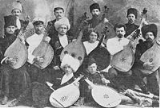
Kuban bandurists
Encyclopedia
A Kuban bandurists is a person who plays the Ukrainian plucked string instrument known as the bandura
, who is from Kuban
, a geographic region of southern Russia surrounding the Kuban River
.
The tradition of the kobzar
in Kuban migrated from central Ukraine
. According to the historian and archivist Ivan Kyiashko the Kuban Cossacks
played on the kobza
, violin
, jaw harp, hurdy-gurdy, basses
, tsymbaly
, and sopilka
.
The Cossacks were especially respectful to itinerant blind singers who played the bandura or kobza. To them, the blind kobzar was a living reminder of their past. In previous eras they themselves were veterans of past battles and campaigns. Their repertoire retold the stories of past battles in the many epic ballads known as dumy
(sung epic poems).
of the Kuban was Antin Holovaty
, who because of his fine the art of playing the bandura was able to gain the territories of the Kuban for the Black Sea Cossack Host
. Songs created by him became popular folk songs which continue to be sung by the Cossacks there today. Some are considered hymns. The bandura became a popular instrument in the hands of Kyrylo Rosynsky who often played for the ataman of the Kuban host Yakiv Kukharenko.
Scholars point to some differences between the bandurist of the Kuban with their counterparts in Ukraine. In Ukraine where the feudal system and mentality had lasted well past its abolishment 1861, the art form survived in the hands of blind itinerant musicians who wandered form village to village with the aid of a young children. In the Kuban the bandura became a symbol and an element of Cossack pride, and as a result the cossack bandurist was usually a young person who had all his faculties. The Kuban bandurists however kept close quarters with itinerant kobzars from Ukraine such as Mykhailo Kravchenko
, Hryhory Kozhushko, Ivan Zaporozhenko and others.
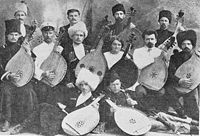
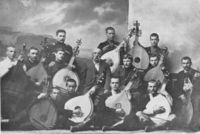

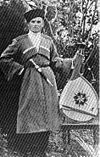
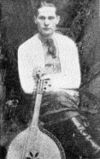 In May 1913 Hnat Khotkevych
In May 1913 Hnat Khotkevych
toured the Kuban with concerts performances. He was invited by Mykola Bohuslavsky to return to Yekaterinodar to run a summer bandura school. Khotkevych declined the invitation, however he suggested a young and promising University Student from Kharkiv - Vasyl Yemetz
. That summer, the first summer kobzar school was organized in Yekaterinodar. Among his students were Antin Chorny, Oleksiy Obabko who continued running the kobzar school after 1916. The next generation included the bandurists Sava and Fedir Dibrova, Vasil Lyashenko, Dokia Darnopykh, Petro Buhay, and the son of the otaman of the Okhtiskaya stanitsa Mykhailo Teliha
(who was shot by the Nazis in 1942 in Kiev
in Babiy Yar), composer of the renowned Cossack March.
, however, the Kuban also had its own bandura makers such as M. Veres (Saratovskaya stanitsa) G. Huzar (Kanevskaya stanitsa) P. Kikot' (Gelendzhik
), Kuzma Nimchenko (Pashkovskaya stanitsa) D. Dykun (Yekaterinodar) S. Tuchinsky (Azovskaya stanitsa). Antin Chorny continued making banduras in Argentina. Initially instruments were diatonically tuned, having some 32 strings. In the mid 1920s chromatic instruments became popular.
.
The first professional Bandurist Capella was organized in Yekaterinodar in 1917 by Kravchenko under the auspices of the Prosvita
organization. This capella existed a year before the establishment of a similar professional bandurist capella in Kiev in 1918. Many of the members of the Kiev Bandurist Capella
were in fact Kuban Cossacks
who had learned to play the bandura in Yekaterinodar.
Kuzma Nimchenko made significant contributions to the development of bandura construction in the late 1920s and early 30s.
Kuban bandurists were very prominent in the Kiev bandurist Capella and also in the establishment of bandura groups in Prague and in the Ukrainian diaspora.
in Kharkiv, Ukrainian Intellectuals seized the opportunity to use tha bandura as a tool for fighting aspsects of the Tsarist regime and as a tool for Ukrainianization. Such prominent writers as Olena Pchilka
and Hnat Khotkevych
noted the importance of using the bandura as a way of affirming national rights. A a result, the Imperial government officials in the Kuban negatively reacted to the rise in the popularity of the bandura.
In the 1920 and early 30s however the bandura flourished in the Kuban. A significant number of Kuban bandurists who had emigrated to the West continued to perform. However, as part of the de-ukrainisation of the Kuban that was implemented in 1930, many of the bandurists such as Svirid Sotnichenko, Konon Bezchasny, Mykola Bohuslavsky were arrested and received terms of imprisonment of 5–10 years or exile. Many more were purged in the Yezhovschina wave of repressions in 1937-38.
, the Kubantsi ensemble and a number of other semi-professional groups. A museum dedicated to the collection of the kobzar and bandura legacy of the Kuban and Crimea is located in Yalta
. The bandura is currently taught in the music college in Krasnodar
. Notable exponents include Yuri Bulavin - the concertmaster of the Kuban Cossack choir. The bandura is being taught in the music college of Krasnodar.
Bandura
Bandura refers to a Ukrainian plucked string folk instrument. It combines elements of a box zither and lute, as well as its lute-like predecessor, the kobza...
, who is from Kuban
Kuban
Kuban is a geographic region of Southern Russia surrounding the Kuban River, on the Black Sea between the Don Steppe, Volga Delta and the Caucasus...
, a geographic region of southern Russia surrounding the Kuban River
Kuban River
The Kuban River is a river in Russia, in the North Caucasus region. It flows mostly through Krasnodar Krai but also in the Karachay-Cherkess Republic, Stavropol Krai and the Republic of Adygea....
.
The tradition of the kobzar
Kobzar
A Kobzar was an itinerant Ukrainian bard who sang to his own accompaniment.-Tradition:Kobzars were often blind, and became predominantly so by the 1800s...
in Kuban migrated from central Ukraine
Ukraine
Ukraine is a country in Eastern Europe. It has an area of 603,628 km², making it the second largest contiguous country on the European continent, after Russia...
. According to the historian and archivist Ivan Kyiashko the Kuban Cossacks
Kuban Cossacks
Kuban Cossacks or Kubanians are Cossacks who live in the Kuban region of Russia. Most of the Kuban Cossacks are of descendants of two major groups who were re-settled in the Western Northern Caucasus during the Caucasus War in the late 18th century...
played on the kobza
Kobza
The kobza is a Ukrainian folk music instrument of the lute family , a relative of the Central European mandora...
, violin
Violin
The violin is a string instrument, usually with four strings tuned in perfect fifths. It is the smallest, highest-pitched member of the violin family of string instruments, which includes the viola and cello....
, jaw harp, hurdy-gurdy, basses
Bass (instrument)
Bass describes musical instruments that produce tones in the low-pitched range. They belong to different families of instruments and can cover a wide range of musical roles...
, tsymbaly
Tsymbaly
The tsymbaly is the Ukrainian version of the hammer dulcimer. It is a chordophone made up of a trapezoidal box with metal strings strung across it. The tsymbaly is played by striking two beaters against the strings....
, and sopilka
Sopilka
Sopilka is a name applied to a variety of woodwind instruments of the flute family used by Ukrainian folk instrumentalists. Sopilka most commonly refers to a fife made of a variety of materials and has six to ten finger holes...
.
The Cossacks were especially respectful to itinerant blind singers who played the bandura or kobza. To them, the blind kobzar was a living reminder of their past. In previous eras they themselves were veterans of past battles and campaigns. Their repertoire retold the stories of past battles in the many epic ballads known as dumy
Duma (epic)
A Duma is a sung epic poem which originated in Ukraine during the Hetmanate Era in the sixteenth century...
(sung epic poems).
Early development
The first known banduristBandurist
A bandurist is a person who plays the Ukrainian plucked string instrument known as the bandura.-Types of performers:There are a number of different types of bandurist who differ in their paricular choice of instrument, the specific repertoire they play and manner in which they approach their...
of the Kuban was Antin Holovaty
Antin Holovaty
Antin Holovaty or Anton Golovaty ; between 1732 and 1744 – ) was a prominent Zaporozhian Cossack leader who after the Zaporozhian Sich's destruction was a key figure in the formation of the Black Sea Cossack Host and their later resettlement to the Kuban Region of Russia.- Early years...
, who because of his fine the art of playing the bandura was able to gain the territories of the Kuban for the Black Sea Cossack Host
Black Sea Cossack Host
Black Sea Cossack Host , also known as Chernomoriya , was a Cossack host of the Russian Empire created in 1787 in the southern Ukraine from former Zaporozhian Cossacks. In the 1790s, the host was re-settled to the Kuban River...
. Songs created by him became popular folk songs which continue to be sung by the Cossacks there today. Some are considered hymns. The bandura became a popular instrument in the hands of Kyrylo Rosynsky who often played for the ataman of the Kuban host Yakiv Kukharenko.
Scholars point to some differences between the bandurist of the Kuban with their counterparts in Ukraine. In Ukraine where the feudal system and mentality had lasted well past its abolishment 1861, the art form survived in the hands of blind itinerant musicians who wandered form village to village with the aid of a young children. In the Kuban the bandura became a symbol and an element of Cossack pride, and as a result the cossack bandurist was usually a young person who had all his faculties. The Kuban bandurists however kept close quarters with itinerant kobzars from Ukraine such as Mykhailo Kravchenko
Mykhailo Kravchenko
Mykhailo Stepanovych Kravchenko was regarded as one of the most outstanding kobzars of Poltava province of the late 19th early 20th century.- Biography :...
, Hryhory Kozhushko, Ivan Zaporozhenko and others.
The Bandura in the 20th century





Hnat Khotkevych
Hnat Martynovych Khotkevych December 31, 1877 in Kharkiv, Russian Empire – October 8, 1938 in Kharkiv, in the Ukrainian SSR of the Soviet Union) was a Ukrainian writer, ethnographer, playwright, composer, musicologist, and bandurist....
toured the Kuban with concerts performances. He was invited by Mykola Bohuslavsky to return to Yekaterinodar to run a summer bandura school. Khotkevych declined the invitation, however he suggested a young and promising University Student from Kharkiv - Vasyl Yemetz
Vasyl Yemetz
Vasyl' Kostovych Yemetz was born in the village of Sharivka, 40 km from Kharkiv, Ukraine. Son of Kost' and Yevdokia . Married to Maria Horta-Doroshenko...
. That summer, the first summer kobzar school was organized in Yekaterinodar. Among his students were Antin Chorny, Oleksiy Obabko who continued running the kobzar school after 1916. The next generation included the bandurists Sava and Fedir Dibrova, Vasil Lyashenko, Dokia Darnopykh, Petro Buhay, and the son of the otaman of the Okhtiskaya stanitsa Mykhailo Teliha
Mykhailo Teliha
Mykhailo Pavlovych Teliha Mykhailo Teliha was an active Ukrainian community leader and distinguished musician. He was born in the Akhtyrka Stanitsa in the Kuban. It is here that he first became interested in playing the bandura in 1913...
(who was shot by the Nazis in 1942 in Kiev
Kiev
Kiev or Kyiv is the capital and the largest city of Ukraine, located in the north central part of the country on the Dnieper River. The population as of the 2001 census was 2,611,300. However, higher numbers have been cited in the press....
in Babiy Yar), composer of the renowned Cossack March.
Bandura making
Many of the banduras used in the Kuban were made by Kiev bandura maker Antin PaplynskyAntin Paplynsky
Antin Paplynsky Kyivan musical instrument maker who crafted banduras from 1905-1918. Rumoured to have been shot by the Bolsheviks in 1919 or 1920. Paplynsky's instruments had 32-34 strings and were diatonically tuned. He was a popular bandura maker because of the quality of his instruments...
, however, the Kuban also had its own bandura makers such as M. Veres (Saratovskaya stanitsa) G. Huzar (Kanevskaya stanitsa) P. Kikot' (Gelendzhik
Gelendzhik
Gelendzhik is a resort town in Krasnodar Krai, Russia, situated on the Gelendzhik Bay of the Black Sea, between Novorossiysk and Tuapse . Greater Gelendzhik sprawls for along the coastline and covers an area of 122,754 ha...
), Kuzma Nimchenko (Pashkovskaya stanitsa) D. Dykun (Yekaterinodar) S. Tuchinsky (Azovskaya stanitsa). Antin Chorny continued making banduras in Argentina. Initially instruments were diatonically tuned, having some 32 strings. In the mid 1920s chromatic instruments became popular.
Significant contributions
Three editions of a Bandura primer were published in Moscow by Kuban bandurist Vasyl ShevchenkoVasyl Shevchenko
Vasyl' Kuzmych Shevchenko - was one of the most active Ukrainian bandurists and torbanists at the turn of the 19-20th century.-Biography:There is not very much detailed information about him. We do know that he was a high school teacher in Moscow teaching singing, having also worked as a stagehand...
.
The first professional Bandurist Capella was organized in Yekaterinodar in 1917 by Kravchenko under the auspices of the Prosvita
Prosvita
Prosvita is a society created in the nineteenth century in Ukrainian Galicia for preserving and developing Ukrainian culture and education among population....
organization. This capella existed a year before the establishment of a similar professional bandurist capella in Kiev in 1918. Many of the members of the Kiev Bandurist Capella
Kiev Bandurist Capella
The Kiev Bandurist Capella is a male vocal-instrumental ensemble that accompanies its singing with the playing of the multi-stringed Ukrainian folk instrument known as the bandura....
were in fact Kuban Cossacks
Kuban Cossacks
Kuban Cossacks or Kubanians are Cossacks who live in the Kuban region of Russia. Most of the Kuban Cossacks are of descendants of two major groups who were re-settled in the Western Northern Caucasus during the Caucasus War in the late 18th century...
who had learned to play the bandura in Yekaterinodar.
Kuzma Nimchenko made significant contributions to the development of bandura construction in the late 1920s and early 30s.
Kuban bandurists were very prominent in the Kiev bandurist Capella and also in the establishment of bandura groups in Prague and in the Ukrainian diaspora.
Early 20th century
After the 1902 Archeological conference12th Archeological Congress
- Preamble :In the 1867 a tradition of holding Archeological Conferences known as Congresses was established in the Russian Empire. The aim of these conferences was to discuss and to make public studies dealing with matters of antiquity and ethnography...
in Kharkiv, Ukrainian Intellectuals seized the opportunity to use tha bandura as a tool for fighting aspsects of the Tsarist regime and as a tool for Ukrainianization. Such prominent writers as Olena Pchilka
Olena Pchilka
Olha Petrivna Kosach , better known by her pen name Olena Pchilka, was a Ukrainian publisher, writer, ethnographer, interpreter, civil activist. Sister of Mykhailo Drahomanov-Early years:...
and Hnat Khotkevych
Hnat Khotkevych
Hnat Martynovych Khotkevych December 31, 1877 in Kharkiv, Russian Empire – October 8, 1938 in Kharkiv, in the Ukrainian SSR of the Soviet Union) was a Ukrainian writer, ethnographer, playwright, composer, musicologist, and bandurist....
noted the importance of using the bandura as a way of affirming national rights. A a result, the Imperial government officials in the Kuban negatively reacted to the rise in the popularity of the bandura.
In the 1920 and early 30s however the bandura flourished in the Kuban. A significant number of Kuban bandurists who had emigrated to the West continued to perform. However, as part of the de-ukrainisation of the Kuban that was implemented in 1930, many of the bandurists such as Svirid Sotnichenko, Konon Bezchasny, Mykola Bohuslavsky were arrested and received terms of imprisonment of 5–10 years or exile. Many more were purged in the Yezhovschina wave of repressions in 1937-38.
The Bandura in the Kuban today
Today the art of the bandura is once again becoming popular in the Kuban particularly amongst the performers of the Kuban Cossack ChoirKuban Cossack Choir
Kuban Cossack Chorus is one of the leading Folkloric ensembles in Russia. Its repertoire and performances reflect the songs, dances and folklore of the Kuban Cossacks.-Early years:...
, the Kubantsi ensemble and a number of other semi-professional groups. A museum dedicated to the collection of the kobzar and bandura legacy of the Kuban and Crimea is located in Yalta
Yalta
Yalta is a city in Crimea, southern Ukraine, on the north coast of the Black Sea.The city is located on the site of an ancient Greek colony, said to have been founded by Greek sailors who were looking for a safe shore on which to land. It is situated on a deep bay facing south towards the Black...
. The bandura is currently taught in the music college in Krasnodar
Krasnodar
Krasnodar is a city in Southern Russia, located on the Kuban River about northeast of the Black Sea port of Novorossiysk. It is the administrative center of Krasnodar Krai . Population: -Name:...
. Notable exponents include Yuri Bulavin - the concertmaster of the Kuban Cossack choir. The bandura is being taught in the music college of Krasnodar.
Further reading
- Энциклопедический словарь по истории Кубани. – Краснодар, 1997.
- Poliovyj R. Kubanska Ukraina. Kiev, Diokor, 2003
- Nyrko О. Joho poslaly za banduru // «Bandura», #65-66, 1998
- Yemetz W.Vasyl YemetzVasyl' Kostovych Yemetz was born in the village of Sharivka, 40 km from Kharkiv, Ukraine. Son of Kost' and Yevdokia . Married to Maria Horta-Doroshenko...
Cossaks-Bandurists - Hollywood, USA 1961

